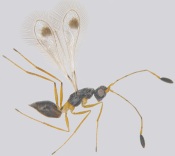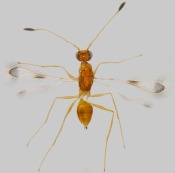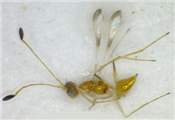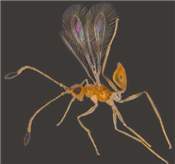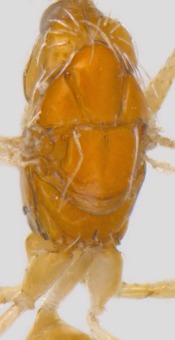Ramesh Kumar et al., 2013
Nomenclature
Palaeoneura Waterhouse, 1915: 537, Type species: Palaeoneura interrupta Waterhouse, designated by Gahan and Fagan (1923).
Chaetomymar Ogloblin, 1946: 277. Type species: Chaetomymar kusetzovi Ogloblin, by original designation. Synonymy by Triapitsyn and Berezovskiy (2007: 38).
Acanthomymar Subba Rao, 1970: 667. Types species: Acanthomymar nigrum Subba Rao, by original designation. Synonymy by Triapitsyn and Berezovskiy (2007: 38).
Diagnosis
Palaeoneura belongs to the Polynema group of genera and can be distinguished by the following characters.
- Female (Figs. 1-6) yellow to dark brown or black
- Antennal funicle 6-segmented (Fig. 8)
- Face usually smooth, without a pit next to each torulus; mandible tridentate (Fig. 7)
- Pronotum having strong, apically truncated setae and axilla with a long, blunt setae extending at least half length of scutellum; mesoscutum with distinct notauli (Fig. 10); propodeum smooth without carinae; propleura abutting each other anteriorly along midline, prosternum thus closed anteriorly
- Fore wing (Fig. 9) usually narrow and slightly narrowing beyond apex of venation but sometimes wider
- Petiole longer than wide, attached posteriorly to gastral tergum (Fig. 10).
Geographic Distribution
Mainly occurs in the Old World only, with majority of the known species from the Oriental region (Triapitsyn and Berezovskiy, 2002). Worldwide, but rare in Neotropical and absent in Nearctic and western Palaearctic regions (Lin et al., 2008).
View Distribution of Palaeoneura in India in a larger map
Hosts and habitat
Recorded on hosts belonging to Lymantriidae and Cicadellidae.
Species in India
1. bagicha (Narayanan et al.) (original description); Huber, (2003) (key and synonymy); Triapitsyn and Berezovskiy (2007) (change of combination); Manickavasagam et al., 2011 (key)
(Distribution: Andaman and Nicobar Islands, Delhi, Maharashtra, Kerala, Tamil Nadu, Uttar Pradesh)
2. indopeninsularis (Mani & Saraswat) (original description); Huber (2003) (key and status revision); Triapitsyn and Berezovskiy (2007) (redescription of Palaeoneura, change of combination) (Distribution: Andaman and Nicobar Islands, Karnataka, Kerala)
3. sophoniae Huber, 2003 (original description, key and distribution); Triapitsyn and Berezovskiy (2007) (change of combination)
4. unimaculata (Hayat and Anis, 1999) (original description, as Acmopolynema unimaculatum); Triapitsyn and Berzovskiy (2007) (change of combination); Manickavasagam et al., (2011) (key to Indian species) (Distribution: Jammu and Kashmir, Karnataka, Kerala, Tamil Nadu)
References
Hayat, M. 1992. Records of some Mymaridae from India, with notes (Hymenoptera: Chalcidoidea). Hexapoda, 4: 83-89.
Hayat, M and Anis, SB. 1999b. The Indian species of Acmopolynema with notes on Acanthomymar (Hymenoptera: Chalcidoidea: Mymaridae). Oriental Insects, 33: 297-313.
Hayat, M, Anis, SB, and Khan, FR. 2008. Descriptions of two new species of Mymaridae (Hymenoptera: Chalcidoidea) from India, with some records. Oriental Insects, 42: 327-333.
Huber, JT. 2003. Review of Chaetomymar Ogloblin with description of a new species in the Hawaiian Islands (Hymenoptera: Mymaridae). Journal of Hymenoptera Research, 12: 77-101.
Mani, MS and Saraswat, GG. 1973. On some Chalcidoidea from India. Memoirs of School of Entomology. St. John's College, Agra, No. 2: 78-125.
Manickavasagam, S., Rameshkumar, A. and Rajmohana, K. 2011. First report of four species of fairyflies from India, key to Indian species of four genera and additional distributional records of Mymaridae (Hymenoptera: Chalcidoidea). Madras Agricultural Journal, 98 (10-12): 393-408.
Narayanan, ES, Subba Rao, BR and Kaur, RB. 1960. Studies on Indian Mymaridae II. (Hymenoptera: Chalcidoidea). Beitrage zur Entomologie, 10: 886-891.
Subba Rao, BR. 1989. On a collection of Indian Mymaridae (Chalcidoidae: Hymenoptera). Hexapoda, 1: 139-186.
Triapitsyn, S. V. and Berezovskiy, V. V. 2007. Review of the Oriental and Australian species of Acmopolynema, with taxonomic notes on Palaeoneura and Xenopolynema stat. rev. and description of a new genus (Hymenoptera: Mymaridae). Zootaxa, 1455: 1-68.
